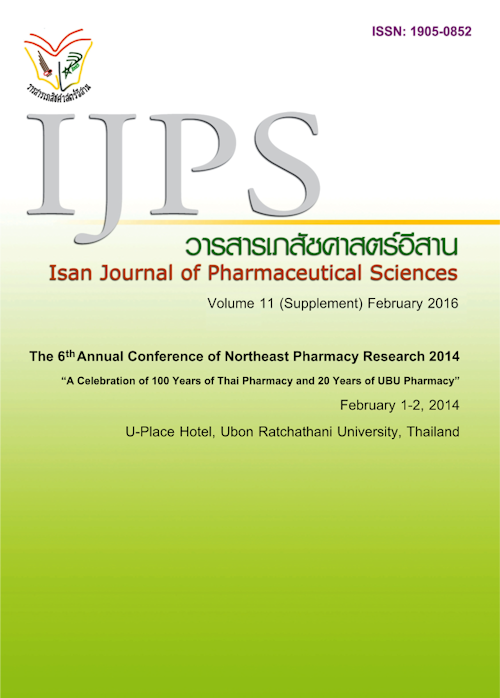Apparent Viscosity and Mechanical Properties Studies of Interpenetrating Network Hydrogel from Natural Rubber and Starch
Main Article Content
Abstract
Introduction: Viscosity and mechanical properties of interpenetrating network (IPN) hydrogel are important for preparation process, film forming/molding and application. This work aims to the study the effects of different types of starch on apparent viscosity and mechanical properties on IPN hydrogel characteristic. Materials and Method: IPN hydrogel was prepared by the free-radical polymerization and was evaluated apparent viscosity before casting at 25ºC. Crosslink density and mechanical properties were also determined for IPN hydrogel. Results: At temperature 25 ºC, natural rubber provides statistically a lower apparent viscosity than pre-gelatinized rice starch and pre-gelatinized banana starch (22.09 ± 12.86, 2957.67 ± 807.51 and 19253.33 ± 5173.60 cP, respectively, p < 0.05). The viscosity of natural rubber mixture increased after starch into mixture. IPN hydrogel with MBA 2 phr comprising of natural rubber and banana starch provides statistically a higher apparent viscosity than IPN hydrogel from rice starch (9607.33 ± 5965.21 cP and 1667 ± 844.88 cP, respectively p < 0.05). It may be due to banana starch has a higher % amylose content than rice starch which lead to require more energy to move. In addition, a higher MBA amount enhanced higher crosslink density and tensile strength as well as lower elongation at break due to the agglomeration of starch granule that show rigid or stiffer. Conclusion: IPN hydrogel comprising of natural rubber and banana starch is not suitable for this work because discontinuous film was appeared during film forming. Rice starch is applicable to use for IPN hydrogel from natural rubber by this method. IPN hydrogel from natural rubber and rice starch is strong but brittle. Thus, it should be develop the mechanical properties in further study.
Article Details
In the case that some parts are used by others The author must Confirm that obtaining permission to use some of the original authors. And must attach evidence That the permission has been included
References
Hoque ME, Ye TJ, Yong LC, Dahlan KM. Sago starch-mixed low-density polyethylene biodegradable polymer: Synthesis and characterization. J Mater 2013; 1-7.
Jagadish NH, Vishalakshi B. Effect of Crosslinking on swelling behaviour of IPN hydrogels of Guar Gum & Polyacrylamide. J. Nat. Prod. Plant Resour. 2012; 4(3): 946- 955.
Puapermpoonsiri U, Pratoomted J, Sila-On W, Watjung C. Water Absorption and Swelling Property of Interpenetrating Network Hydrogel from Crosslinked Natural Rubber and Modified Rice Starch. Adv Mat Res 2014; 844: 73-76.
Sila-On W, Pratoomted J, Puapermpoonsiri U, Watjung C, Pitchayakorn W. Thermal and Mechanical Properties of Natural Rubber/Rice Starch Interpenetrating Network Hydrogel. Adv Mat Res 2014; 844: 77-80.
Saijun D, Nakasonl C, Kaesaman A, Klinpituksa P. Water absorption and mechanical properties of water-swellable natural rubber. Songklanakarin J 2009; 31(5): 561- 565.
Xie F, Yu L, Su B, Liu P, Wang J, Liu H, et al. Rheological properties of starches with different amylose/amylopectin ratios. J Cereal Sci 2009; 49(3): 371–7.
Yue Y, Sheng X, Wang P. Fabrication and characterization of microstructured and pH sensitive interpenetrating networks hydrogel films and application in drug delivery field. Eur Polym J 2009; 45(2): 309–15.


